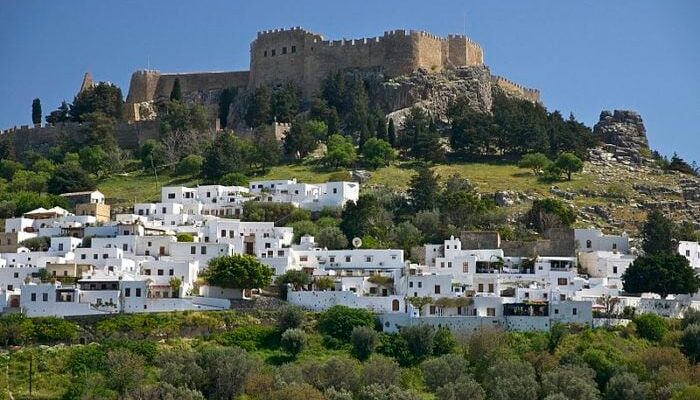The history of the Acropolis of Lindos on Rhodes is as old as the history of ancient Greece, as tradition has Lindos participating in the fabled Trojan War.
The same tradition says that Lindos was founded by Danaos, and it was the ruler Tlepolemus, the son of Heracles and Astyoche, who sided with the Achaeans against the Trojans in the conflict.
Lindos was a member of the Doric Exapolis, and on its citadel, it had the famous temple of Athena Lindia, which took its final form in 300 BC.
Today, the Acropolis of Lindos is the main archeological site of Rhodes, with the 116-meter (381-foot) high cliff dominating the town and overlooking the sea.
It is a natural fortification that was used by the ancient Greeks and by the Romans, Byzantines, Knights of St. John, and Ottomans later on.
Lindos’ rich history, combined with the unique natural beauty of the site, make the Acropolis of Lindos the third most popular archaeological site in Greece in terms of visitors.
History of the Acropolis of Lindos
The temple dedicated to the goddess Athena is estimated to have been constructed during the 9th century BC. By 700 BC, Lindos was already an important commercial center in the region and a mighty naval power, as well.
Lindos flourished in archaic times under the rule of the moderate tyrant Cleobulus, considered one of the Seven Sages of Greece, during the 6th century BC.
In classical times, although a Doric city, it participated in the Alliance of Delos, but during the Peloponnesian War, it allied with the Lacedaemonians. Its importance gradually faded after the founding of Rhodes in 407 BC.
Lindos has been continuously inhabited over the centuries. It has a rich history, as proven by the numerous archaeological findings from the archaic era and later.
The construction and reconstruction of the acropolis continued during the Roman and Byzantine eras, leaving traces to this day.
As Christianity was rising, ancient temples were converted to Christian churches. What remains today are the Castle of the Knights of St. John, which was an expansion of earlier Byzantine fortifications.
When the Ottomans took over, it was used as a fortress. Unfortunately, no effort was made for its restoration.
At the beginning of the twentieth century, Danish archaeologists Kinch and Blinkenberg conducted excavations in southern Rhodes and the Acropolis of Lindos.
Their findings were transported out of the country; now, they are on display at the Copenhagen Museum. After the occupation of Rhodes by the Kingdom of Italy, Italian archaeologists also conducted research throughout Rhodes.
A great deal of restoration work was done on the Acropolis of Lindos by the Italians, who recognized the importance of the site.
After the Dodecanese passed into the hands of the Greek state after World War II, continuation of restoration works was undertaken by the Hellenic Archaeological Service from 1948 onward.

The temple of Lindia Athena
In ancient times, the citadel of Lindos had as its central place of worship the temple of Lindia Athena.
According to Greek mythology, when Danaos left Egypt with his daughters, he sailed to Lindos, where he was warmly received by the inhabitants.
Danaos built the sanctuary of Lindia Athena and dedicated a statue to the goddess before sailing to Argos.
It is not known exactly when the original temple was built. Historical evidence suggests it was built in the 6th century BC.
The ruler of Lindos, Cleobulus, restored the sanctuary around 342 BC but it was later destroyed by fire.
Archaeologists estimate that the Doric type temple of Athena, parts of which survive to this day, were actually built in the 4th century BC.
During the Classical and Hellenistic eras, the sanctuary of Lindia Athena had a pan-Hellenic reputation, and during the heyday of the Rhodian State, the Acropolis of Lindos was further embellished, as impressive Propylaea, a Stoa, and wall were built.
Especially noteworthy is the relief of a triumvirate that is preserved at the base of the archaeological site of the acropolis and dates back to the second century BC.
Structural, architectural, and fortification elements
On the Acropolis of Lindos, the most important monuments belong to antiquity, with the Doric temple of Athena standing out among them.
Other important monuments are the Propylaea of the holy temple from the same era and the Hellenistic Stoa, dating back to 200 BC, which is 87 meters (285 feet) long with 42 columns.
There is also the Rhodian trireme that is embossed on a rock at the foot of the citadel from 180 BC and the Hellenistic wall that surrounds the citadel.
From the era of the Knights of St. John survives the Castle that was built shortly before 1317, constructed on top of a Byzantine structure.
On the south side, a pentagonal building overlooked the entire port, as well as the fortress and the road.
Representing the Byzantine era onward, there is the Church of Agios Ioannis, built around the 13th or 14th century, on top of another church that must have been built in 500 AD.
The ancient theater of Lindos
The ancient theater of Lindos is another archaeological monument, situated at the foot of the west slope of the Acropolis of Lindos.
The theater, which dates back to the 4th century BC, had a capacity of 1,800 to 2,000 spectators.
It is connected to the great city festivals in honor of Dionysos, the Sminthia, which included theatrical, musical and athletic competitions, processions, and sacrifices.
In the third century BC, directly adjacent to the theater, there was the Tetrastoon, a rectangular building with an internal colonnade, which was perhaps a sanctuary of Dionysos Smintheus.
Today, the only rock-carved sections preserved there are the circular orchestra, the three central cunei of the lower cavea, and parts of the two neighboring ones, as well as the central section of the upper cavea.



